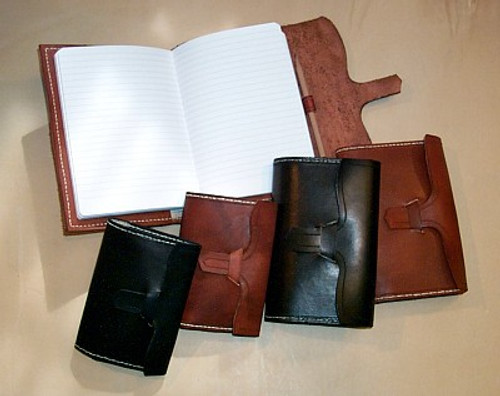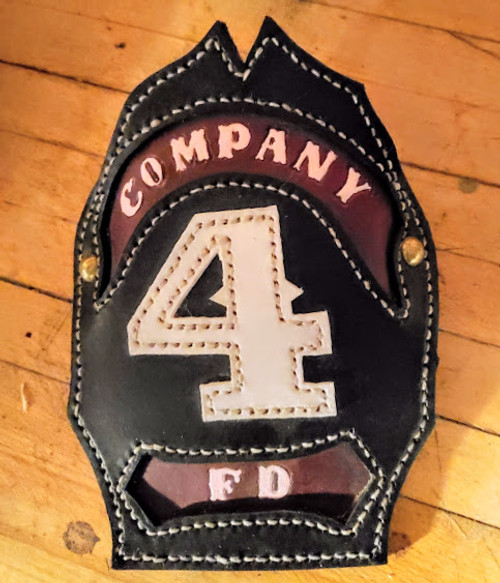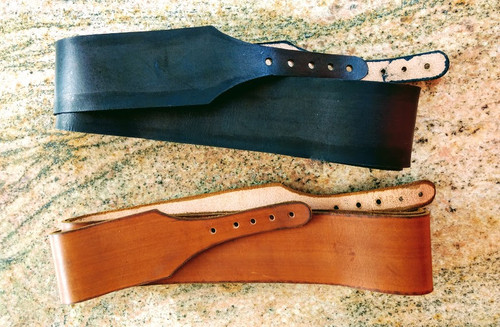Period sling from 1858 to 1862 pattern with Japanned roller buckle and 2 keepers (a small leather ring that was used to secure the strap). Protective flap sewn into back of buckle. Sides of strap are grooved and the edges are dyed. The keeper is hand stitched onto strap. Made of 5-6 oz. leather 5/8", 3/4", 1" or 1-1/4" in width and is 6 feet in length. Lengths are adjustable and can be made longer by special request.
Historical Citation:
| Canteen
The following is a survey done by “The Watchdog” which represents the percentage of canteen covers and slings that reside in museums. Canteen Covering Sling Cork Attachment This survey not only allows us to see what has survived the war, but gives us some ideas on how to improve the impressions of Civil War reenacting units. Usually the term “authentic” in the reenacting community translates into “expensive.” This is one aspect of every reenactor’s impression that can be improved inexpensively. The author’s suggestion: Buy two square feet of jean or coarse woolen material, use the old cover as a pattern, and recover your canteen. When your cork chain rusts through. Find some twine. ATTACHMENT: to the loop of the cork wire and one of the loops of the canteen, should be a strong piece of cotton or linen twine, made with 4 threads, hard twisted. 20 inches long and doubled together to prevent the loss of the cork. COVERING: A coarse cheap woolen or woolen and cotton fabric. SLING: to be of leather with a buckle, 3/4" wide and 6 feet long. — The Watchdog, Vol. 2 #2; Vol. 1 #4; Vol. 4 #4; Vol. 5 #3 *NOTE: These are the sources that the Watchdog used in writing this article.
The Civil War Issue Canteen; patterns of 1858 and 1862 "Between 1861 and 1865 virtually every Union soldier received and carried a tin canteen, making it one of the most readily identifiable artifacts of the American Civil War. This universal issue also accounts for the numerous examples (available on today's collector market). At first glance the canteens may all appear to be exactly the same. Certainly size and shape vary so little from a standard that the casual observer may notice no difference. But, important differences do exist, and it is the purpose of this article to detail, date and where possible, explain the variations which may be encountered. FIG 1. Leather straps 5/8 to 1 inch wide had been used by the U. S. Army since at least the War of 1812. However, they would be discontinued by the winter of 1862/63. At the outbreak of the Civil War in 1861, the U. S. Army Quartermaster Department (QMD) had decades of experience in the manufacture and procurement of uniforms and equipage. This was a thoroughly professional organization that knew what it wanted, and usually got it. They were no strangers to innovation, and often experimented with new products from the civilian market. They set high standards for items to be issued by them to the Regular Army. They also knew that, in an emergency, substitution and deviation from the standard was often necessary. As long as the end product met the needs of the soldier, set standards would at times have to take a back seat to necessity. The tin canteens procured and issued by the QMD's Office of Clothing & Equipage between 1861 and 1865 would be the embodiment of all of the above. The tin-plated, oblate spheroid canteen was the result of a long series of tests and experiments with various designs and materials. The most extensive material tested was tin-plated sheet iron. Tin had replaced cedar as the material of choice for canteens in the 1840's."
|












